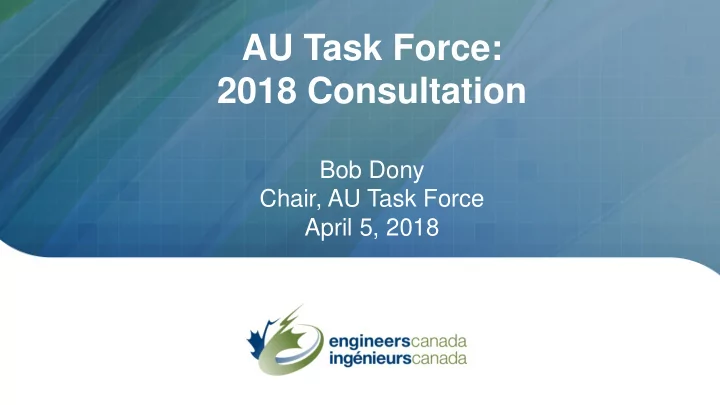

AU Task Force: 2018 Consultation Bob Dony Chair, AU Task Force April 5, 2018
Outline About the AU Task Force 1 2 AU Task Force timelines 3 National consultation objectives, process, and timelines 4 The AU Task Force Report and recommendations 5 Next steps
About the AU Task Force 7 members from across Canada • representation from regulators, CEAB, NCDEAS, academia, industry With a mandate to: • consider the definition of an AU in its present form (criteria 3.4.1.1) and to identify the advantages, disadvantages and ramifications of any definition change on existing criteria. • envisage how curriculum content requirements could be linked to student outcomes/graduate attributes whatever system of AU counts is used.
AU Task Force timelines Task force struck Survey of NCDEAS Draft report Execute consultation FEB ’17 OCT ’17 WINTER ’18 SPRING ’18 JUL ’17- AUG ’16 FALL ’17 FEB ’18 JAN ’18 Forum on Task Force Review of white Submit report Accreditation meetings papers/historical research/ environmental scan
Approve consultation plan - Task Force, CEAB Chair, VP Execute consultation (March 21-June 3) Consolidate data Draft consultation report (June) National consultation Approve consultation report -Task Force, CEAB Chair, VP Publish consultation report (July) Consider final recommendations - Task Force, CEAB, EC Board Execute recommendations (October) Evaluate consultation and log lessons learned Legend: Decision point Workplan process
National consultation: objectives 1. Inform stakeholders of an alternate curriculum measurement methodology being considered. 2. Investigate stakeholder reaction to the report recommendations. 3. Consolidate and synthesize stakeholder feedback with the objective of putting forward a list of recommendations for implementation. 4. Identify barriers to change if the report recommendations are adopted. 5. Develop a reasonable implementation plan that accommodates the diverse viewpoints of stakeholders.
Stakeholders to be consulted • CEAB members • CEQB members • CFES • National Council of Deans of Engineering and Applied Science (via the Dean’s Liaison Committee) • Executive Committee, Engineers Canada • Engineering regulators’ councils/Boards of examiners/Academic review committees • National Admissions Officials Group (NAOG)
Task Force Report • Reviewed by the CEAB (Feb. 10) and received by Engineers Canada Board (Feb. 28) • Submitted to all accreditation stakeholders for consultation • Confirms Task Force deliverables • Four recommendations Available on EC website
3.4 Curriculum Content: Measurement slide 9 of 20
Recommendation 1 It is the recommendation of the Task Force that the CEAB consider adding additional flexibility to measuring curriculum. This could be achieved by developing an interpretive statement for criterion 3.4.1.4 on the “Learning Unit”: Learning Unit: Equivalent to N hr learning time, as established by focused learning time for all learning activities through (a) student surveys as part of course evaluations and (b) instructor expectations to be stated in course outlines. In the case of conventional learning activities, learning time measurements are used for formative feedback only, AU’s assigned as in the past.
Recommendation 2 It is the recommendation of the Task Force that a preliminary measure of a Learning Unit be equivalent to 2.5 hours of learning time.
Recommendation 3 It is the recommendation of the Task Force that the CEAB enter a national consultation on the Task Force’s recommendations 1 and 2.
Recommendation 4 The Task Force recommends that [the initiative to linking AUs with graduate attributes] be continued with the creation and presentation of concrete examples based on currently accredited program data to demonstrate the benefits accrued by applying the linking method. Should a method to link curriculum to outcomes be adopted, the implementation timelines will consider any redefinition of AU.
Consultations: What to expect We are working with stakeholders to schedule 1-hour webinars or face-to- face meetings with stakeholders. During the consultations we will: a) Present the Task Force’s four recommendations b) Ask 5 questions about recommendations 1 and 2 c) With your permission, audio record our conversation d) Address your questions, hear your feedback, and consider your point- of-view Notes from each meeting will be provided to stakeholder groups for verification
Our questions Recommendation #1 Recommendation #2 1. Does the definition of the “Learning Unit” offer 1. Is the Learning Unit as equal to 2.5 hours of sufficient flexibility to measure curriculum learning time appropriate? content that is not actual contact time between student and faculty members? 2. If we were to implement this recommendation 2. Does the definition of the “Learning Unit” today, what are the unintended compromise the quality of the engineering consequences? That is, if something could go degree? wrong, what would it be? 3. Do the recommendations affect your level of confidence in the established accreditation process? 4. If we were to implement this recommendation today, what are the unintended consequences? That is, if something could go wrong, what would it be?
Next steps Written responses can be submitted to: • We are scheduling meetings with groups of stakeholders accreditation@engineerscanada.ca • This webinar has been recorded and or by mail to: will be available on our website: AU Taskforce c/o Mya Warken Engineers Canada www.engineerscanada.ca/accreditation/consultation-AU-task-force 300-55 Metcalfe St. Ottawa, ON K1P 6L5 Submission deadline: May 30, 2018
www.engineerscanada.ca/accreditation/consultation-AU-task-force
Thank you For more information: accreditation@engineerscanada.ca | 613.232.2474 engineerscanada.ca/accreditation
Recommend
More recommend